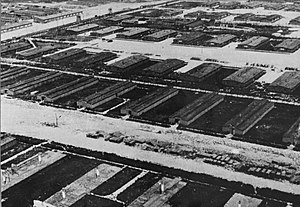German Equipment Works
| Deutsche Ausrüstungswerke (DAW) | |
|---|---|
| Majdanek | |
 Aerial reconnaissance photograph of the Majdanek concentration camp (June 24, 1944) from the collections of the Majdanek Museum; lower half: the barracks under deconstruction with visible chimney stacks still standing and planks of wood piled up along the supply road; in the upper half, functioning barracks | |
| DAW operation | |
| Period | 1939 – 1943 |
The Deutsche Ausrüstungswerke (DAW; literally the German Equipment Works) was a Nazi German defense contractor with headquarters in Berlin during World War II, owned and operated by the Schutzstaffel (SS). It consisted of a network of requisitioned factories and camp workshops across German-occupied Europe exploiting the prisoner slave labour from Nazi concentration camps and the Jewish ghettos in German-occupied Poland. DAW outfitted the German military with boots, uniforms and materials on the eastern front at a windfall profit,[1] provided wood and metal supplies, as well as reconstruction work on railway lines and freight trains.[2]
History
The business enterprise was founded in May 1939 and was in operation until 1943. About 15,500 concentration camp prisoners died at DAW due to heavy work loads imposed by the contractor and the inhuman working conditions "calculated not just to cripple their bodies but also to plunge them into a state of perpetual terror."[1] DAW operated several businesses in the Dachau Concentration Camp, Sachsenhausen, Buchenwald, Auschwitz, where forced labor was used. Work was later expanded to Majdanek concentration camp, KZ Lviv, Stutthof, and other camps.
Deutsche Ausrustungswerke (DAW) was the first SS enterprise established in the Lublin reservation territory of occupied Poland sometime between late 1940 and early 1941. DAW took over the Lipowa Zwangsarbeiterlager with prisoners of the Lublin Ghetto,[3] and soon expanded to include Lublin Airfield, and the Majdanek concentration camp labour force in October 1941.[4] DAW was subordinate to the SS-WVHA.[5] The Lublin Airfield was a location of several of its plants including a subsidiary of the Waffen SS clothing workshops, the SS garrison, a glass factory, a truck and the SS troop supply depot, and a prisoner lab producing pharmaceuticals.[3]
By mid-1942, all death camps of Operation Reinhard were already supplying trainloads of goods from the victims of gassing for further processing: the Bełżec extermination camp from March 1942, Sobibór from May 1942, and Treblinka from July 1942.[6] The remaining Jews in the General Government supplied DAW with slave labour. Globocnik directed the operation of DAW plants in Lublin and at the Old Airfield camp, the Waffen SS Standortverwaltung workshops and SS Clothing Works, and the police Truppenwirtschaftlager Supply Depot of the HSSPF. All labourers and guards were supplied by Globocnik.[3]
"The prime example of cooperation between the WVHA and Globocnik – wrote White – was the East Industries Inc. (Ostindustrie GmbH, or Osti), which was founded in March 1943 for the express purpose of using Jewish labor and also exploiting machinery and raw materials formerly owned by Jews in industrial workshops." Therefore, the equipment used by DAW was not German to begin with, but Polish. Osti took over DAW factories in 1943.[3]
See also
- Organisation Todt (OT) civil and military engineering group from Nazi Germany
Notes
- ^ a b Judith M. Hughes (2014). The Holocaust and the Revival of Psychological History. Cambridge University Press. pp. 103–105. ISBN 1107056829.
- ^ "Deutsche Ausrüstungswerke (DAW)" (PDF). Offenes Archiv, Hamburg. 1/8 – via Open Archives, Neuengamme Concentration Camp Memorial.
{{cite journal}}: Cite journal requires|journal=(help) - ^ a b c d Elizabeth B. White (1997). "Annual 7: Chapter 1". Majdanek: Cornerstone of Himmler's SS Empire in the East. Los Angeles, California: Simon Wiesenthal Center, Multimedia Learning.
- ^ "Założenia i budowa (Purpose and construction, selection of photographs)". Majdanek concentration camp. KL Lublin Majdanek.com.pl. Archived from the original on January 2, 2011. Retrieved 2013-04-18.
Concentration camp name change 9.04.1943.
{{cite web}}: Unknown parameter|deadurl=ignored (|url-status=suggested) (help) - ^ Dobroszycki, Lucjan (1984). "Introduction (Ostindustrie)". The chronicle of the Łódź Ghetto: 1941-1944. Yale University Press. p. lxi. ISBN 0300039247. Retrieved 17 December 2015.
- ^ McVay, Kenneth (1984). "The Construction of the Treblinka Extermination Camp". Yad Vashem Studies, XVI. Jewish Virtual Library.org. Retrieved 17 December 2015.
References
- The Simon Wiesenthal Center (1997), Cornerstone of Himmler's SS Empire in the East by Elizabeth B. White. Annual 7; Chapter 1.
- Jan Erik Schulte: Forced labor and extermination. The business empire of the SS Oswald Pohl and the SS Economic and Administrative Main Office from 1933 to 1945. Paderborn 2001, ISBN 3-506-78245-2.
